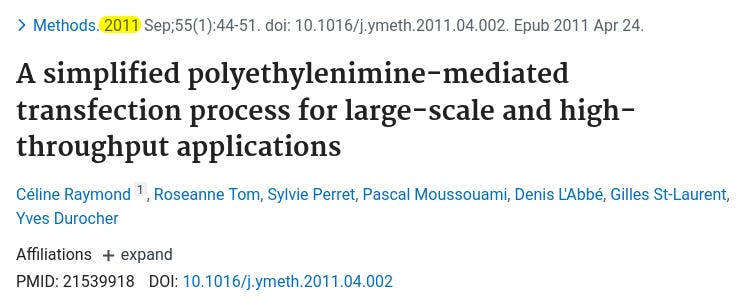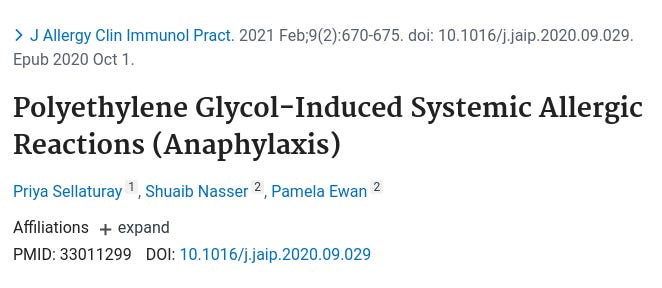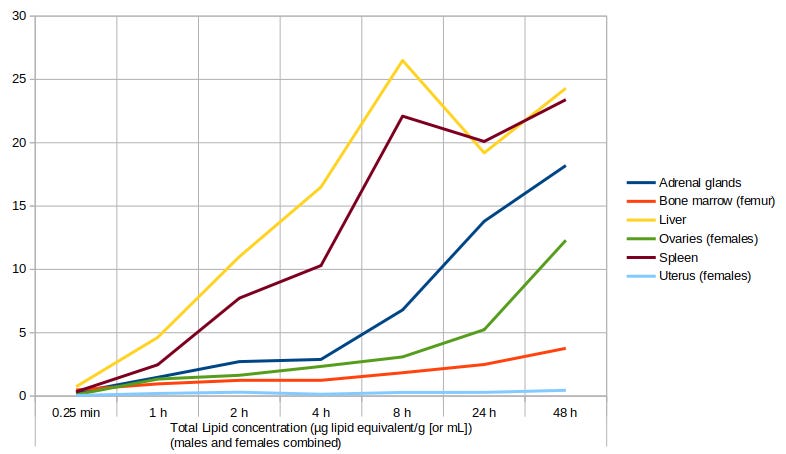The Transfectant Agent Found In Your Food
Yet more chemicals aid plasmid DNA uptake into cell DNA
Introducing polyethylenimine (PEI), the WHO INCHEM (Internationally Peer Reviewed Chemical Safety Information) approved chemical which cheerily states:
Polyethylenimine is an immobilizing agent used in the production of enzyme preparations for food processing. The substance is also used in food packaging materials.
Food processing and food packaging! Woo! Special delivery!
In the section on mutagenicity it admits polyethylenimine might be mutagenic:
A sample of polyethylenimine obtained prior to cross-linking with ethylene dichloride was mutagenic to strains TA1535 and TA100 both in the presence and absence of the activation system.
Evaluations of the Joint FAO/WHO Expert Committee on Food Additives insightful solution to the problem? Well, they didn’t ban it. They just said basically ‘try to keep it down, if you can’.
Yeah, because the industry is so good at self-regulation and definitely not rife with fraud. Especially not $2.3 billion’s worth of fraud.
Other services go much further, suggesting this ‘maybe’ mutagenic transfectant agent for all sorts of things, including water treatment!
Transfectant agent water drink… yum?
Surely though this is a recent thing, and purely just an accidental contamination; after all, they’re only making food packages (and water treatments), they couldn’t possibly be conspiring or planning to use it to transfect plasmid DNA into…
Sigh. It’s dated 2002. Nice of them to not warn us.
For those of you not familiar, ‘nucleus trafficking’ is just a fancy way of saying ‘enters the nucleus’, which in our article “DNA Modifications Impact The Next Generation” we pointed out basically means ‘integrates into the cell DNA’. Your cell DNA.
So, it helps plasmid DNA modify cell DNA. But wait, maybe this is just one collection of crazy scientists random experimentation with polyethylenimine. They definitely wouldn’t be trying to use it to produce ‘recombinant proteins’ en-mass way before 2020…
Oh. Maybe they are.
Maybe this is just two collections of crazy scientists random experimentation with polyethylenimine. There’s no way they’d be trying to improve it now and also be using it in any ‘vaccines’…
Oh come on. They are looking for improvements so they can use it in 'DNA vaccines' and 'gene therapy' (read: genetic modification) shots. Huh, funny that, they’re putting the food packaging into the shot they’re planning on shooting up your veins. The mutagenic food packaging.
But it isn’t the only food additive with problems…
Enter PEG
Short for polyethylene glycol. Avid readers of the Daily Beagle and Pfizer package inserts will almost immediately recognise it.
We made reference to it before in the article “How Long Do Pfizer Lipids Last?”, where we pointed out ALC-0159 is a “PEGylated” LNP (lipid nanoparticle), and in much greater depth in “The Disastrous Duo: Lipids And Unstable mRNA” where we detailed how ALC-0159 breaks down to leave behind Polyethylene Glycol 2000 and is harmful to male rats.
PEG is infamous for causing allergic reactions…
…and this allergy is associated with the shots:
Readers will recall how The Daily Beagle reported a skyrocketing increase in anti-allergy medications after the rollout of the shots.
Additionally, readers might recall in the Pfizer/BioNTech document published in “JW-v-HHS-prod-3-02418” (pages 461-462) we saw that LNPs ended up in various organs of the body.
Such numbers might be hard to visualise, so we isolated a few organs where the LNPs dump themselves, and present it as graph form:
Where-ever the LNPs go, the PEGylated components go with them. If you recall, the liver is what converts the PEGylated LNPs into PEG-2000, and if you look at the yellow line above, you’ll see some of the LNPs get dumped into the liver.
They don’t stay in the arms, contrary to usually peddled propaganda.
PEG Aids Transfection
How could PEG aid in transfection of DNA into a cell? PEG aids the adhesion of DNA to the surface of a cell.
It can also induce genetic transformation in bacteria and yeast cells (implying it may do the same in human cells):
PEGylated nanocomplexes have also been proposed for use in gene modification (‘gene therapy’) due to their efficiency and ability to penetrate tissues. Based on the graph of the LNPs (a type of PEGylated complex) this is true. ‘In vivo’ means ‘in living’:
PEG is also used in PEG-Liposome (not to be confused with LNPs) transfection kits used, you guessed it, ‘in living’, and uses plasmid DNA.
In-fact, it is sold as a purchasable product (notice it boasts it ends up in the spleen, kidney, pancreas and liver, similar to our LNPs graph above, which includes liver and spleen):
Whilst there’s no clear evidence (yet) that PEG acts like a complete transfection agent, it is clear it is very much a ‘partner in crime’ that is always seemingly there whenever transfection happens and clearly aids it.
Whichever plasmid DNA transfection approach Pfizer & Co use, they have plenty of time to do it in. Plasmid DNA was stable even at 65 Celsius for 20 days…
…and at room temperature, DNA (note: not strictly plasmid DNA) took 9 months before it started to degrade:
Oh, and if linearised plasmid DNA is found in the shots? Well, it being linear makes it far more efficient at becoming stable (read: permanently integrated into cell DNA) rather than ‘transient’ (temporarily integrated):
Temporarily or permanent, or shouldn’t be letting them get away with doing this.
Related Articles To Read
Subscriber Poll
Found this informative? Bypass censorship and receive more for free!
Help improve The Daily Beagle’s reach?
What do you think, dear reader? Let us know in the comments.
























This ties in with the FDA allowing 2% of the total weight of food to include pretty much anything at the onset of the plandemic - likely as a means to either weaken immune systems or as accelerates to the stroke poke objectives, or both: https://tritorch.com/degradation/FDAAllows2PercentOfIngredientsToBeReplacedWithAnythingMay2020.pdf
It is astonishing how well planned and coordinated this genocide/transhuman military operation is.
Great work, I stumbled across PEG eight or nine years ago when I had to buy litres of it as the heat exchange fluid in evacuated tube solar panels, from there I saw it appear as the substrate in vaping products and then on to lipid nanoparticles... 'Industrial fat'. Doesn't sound good does it? Has a plethora of other uses to, in processed foodstuffs etc. I read it was a byproduct of biofuel production but I am not so sure given its widespread use.
AVOID.